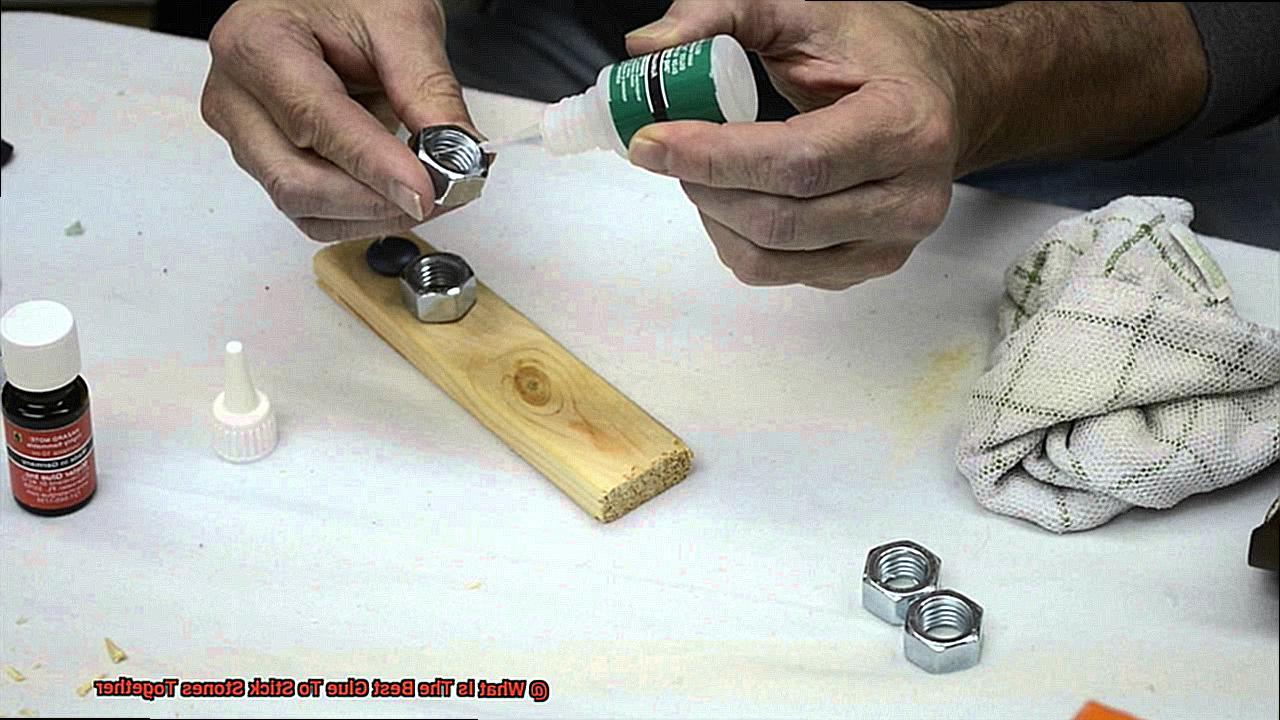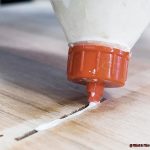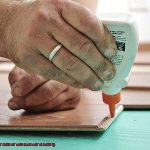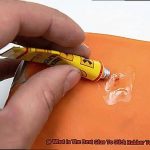Looking to create stunning stone art or repair your beloved stone jewelry? Well, my friend, you’ve come to the right place. Finding the best glue to stick stones together can be a wild adventure, whether you’re a crafty newbie or a seasoned pro. With countless options out there, we’re about to embark on a journey that will unearth the hidden gems of adhesives, revealing the absolute best for flawless stone bonding.
Join me as we dive headfirst into the world of adhesives, uncovering secrets that will ensure your stones stay connected for eternity. From natural stone sculptures to intricate mosaics, mastering the art of stone bonding demands an eye for detail and the perfect adhesive.
Different stones call for different glues. Super glue is a crowd favorite due to its lightning-fast drying time and super-strong hold. But beware. It may not be compatible with all stone types and can leave behind an unwanted shiny residue that steals attention from your precious gems.
If versatility and durability are what you seek, then epoxy resin is your knight in shining armor. This magical adhesive works wonders indoors and outdoors alike. It’s tough as nails but requires careful mixing and might not dry as fast as other options.
Now, delicate or porous stones like marble or sandstone deserve special treatment. Enter stage left: stone glue. This specialized adhesive is designed specifically to bond these fragile beauties without causing any harm or unsightly stains.
Stick with us as we unravel the mysteries of stone bonding and dish out expert advice on which glue suits various stone art projects. We’ll help you discover the adhesive that’ll take your creations from ordinary to extraordinary—guaranteeing longevity and beauty that’ll withstand the test of time.
In our upcoming posts, we’ll explore each adhesive’s pros, cons, and proper techniques for use. Plus, we’ll sprinkle in some pro tips and tricks to ensure your stone bonding is flawless—no matter the size, shape, or composition of your stones.
So, buckle up for an enchanting journey through the intricate world of stone adhesives. We’re about to dive deep into the nitty-gritty details and uncover the adhesive that not only bonds stones but also seals your passion for all things stone art.
Types of Glue for Sticking Stones Together
Contents
- 1 Types of Glue for Sticking Stones Together
- 2 Factors to Consider When Choosing a Glue
- 3 Epoxy Resin: The Best Glue for Sticking Stones Together
- 4 Construction Adhesive as an Alternative
- 5 Jewelry Glue and Gemstone Glue
- 6 Drying Time of the Glue
- 7 Cleaning and Roughening Surfaces Before Applying Glue
- 8 Testing the Bond Before Applying to Entire Project
- 9 Conclusion
The secret behind their flawless construction lies in the glue used to bind those stones together. With various types of glue available, each offering unique properties and strengths, it’s essential to choose the right adhesive for your stone project. In this article, we will delve into the different types of glue commonly used for sticking stones together and explore the factors that should guide your selection.
Epoxy Resin – The Indomitable Hero:
When it comes to bonding stones, epoxy resin emerges as a true hero. Its mighty strength and durability can withstand the test of time, making it the ultimate choice for creating stone jewelry or repairing fractured stone objects. With options like clear or colored formulations and varied curing times, epoxy resin allows you to tailor its usage to suit your project perfectly.
Super Glue – The Flash of Adhesives:
For small stones or projects demanding a quick-drying adhesive, super glue, also known as cyanoacrylate adhesive, reigns supreme. It dries in a flash, forming an unyielding bond. However, it’s crucial to remember that certain porous stones may not adhere well to super glue, so a preliminary test is essential.
Silicone Adhesive – Flexibility Redefined:
For projects exposed to moisture or outdoor settings, silicone adhesive becomes your steadfast companion. This waterproof adhesive offers unparalleled flexibility and exceptional adhesion properties. It ensures that your stones stay firmly affixed even in the face of challenging conditions.
Construction Adhesive – Mightiness Personified:
When dealing with large or heavy stones, construction adhesive or polyurethane adhesive steps up to the plate. These robust adhesives surpass regular glue in strength and durability, forging a bond that can endure immense pressure and weight.
Considering the Factors:
Choosing the right glue for your project involves careful consideration of several factors. Size and weight of the stones, the intended use of the bonded stones, and the conditions they will be subjected to are all critical elements. Additionally, following the manufacturer’s instructions, thoroughly cleaning stone surfaces, and conducting a small area test before full application are vital steps to ensure success.
Factors to Consider When Choosing a Glue
When it comes to selecting the best glue for your stone crafting project, there are several factors to consider. Each factor plays a crucial role in ensuring a strong and durable bond that will stand the test of time. Let’s dive into these factors and explore why they are important.
- Type of Stone: Different stones have varying textures and porosities, making it essential to choose a glue specifically designed for bonding stone surfaces. This ensures that the adhesive will adhere effectively, creating a secure bond.
- Strength and Durability: Stones can be heavy, so it’s crucial to select a glue with high bond strength to securely hold them together. Look for adhesives that are resistant to water, heat, and other environmental factors that could weaken the bond over time.
- Drying Time: Consider how quickly you want your project to be completed. Some glues dry quickly, allowing you to move forward with your project sooner. Others may require more time to fully cure and reach their maximum bonding strength. Patience may be required for those wanting the strongest possible bond.
- Ease of Use: Choose a glue that suits your skill level and comfort in handling it. Some glues require mixing or special application techniques, while others come in convenient squeeze bottles or tubes. Opting for an easy-to-use adhesive will make your stone crafting experience more enjoyable.
- Visibility: Think about how visible you want the glue to be once it dries. If you prefer an invisible or blended-in look, go for a clear or colorless glue. On the other hand, if you want to add a decorative touch, opt for a colored or glittery adhesive that will enhance the overall aesthetic of your project.
- Safety Precautions: Prioritize your safety when working with glue. Some adhesives may emit strong fumes or contain toxic substances, so it’s important to follow the manufacturer’s instructions and take necessary precautions such as proper ventilation or wearing protective equipment. Safety should always be the top priority.
Epoxy Resin: The Best Glue for Sticking Stones Together
Are you searching for the ultimate glue to stick stones together? Look no further than epoxy resin. This remarkable two-part adhesive is renowned for its exceptional strength and durability, making it the top choice for crafters, DIY enthusiasts, and professionals alike. Let’s delve into why epoxy resin reigns supreme as the go-to glue for sticking stones together.
First and foremost, epoxy resin boasts unparalleled strength and durability. When the resin and hardener are combined, a chemical reaction occurs, resulting in a bond that can endure heavy loads and resist impacts. Once your stones are secured with epoxy resin, they are there to stay.
Additionally, epoxy resin exhibits excellent resistance to moisture and chemicals. This makes it perfect for outdoor applications where stones may face exposure to water or harsh conditions. Whether you’re fashioning a breathtaking garden sculpture or a mosaic stepping stone, epoxy resin will steadfastly hold your stones in place.
What sets epoxy resin apart is not just its formidable bonding capabilities; it can also fill gaps or cracks in stones flawlessly. This allows for a seamless finish that enhances the overall aesthetics of your creation. Whether you’re mending a fractured stone or crafting a one-of-a-kind art piece, epoxy resin guarantees a flawless result.
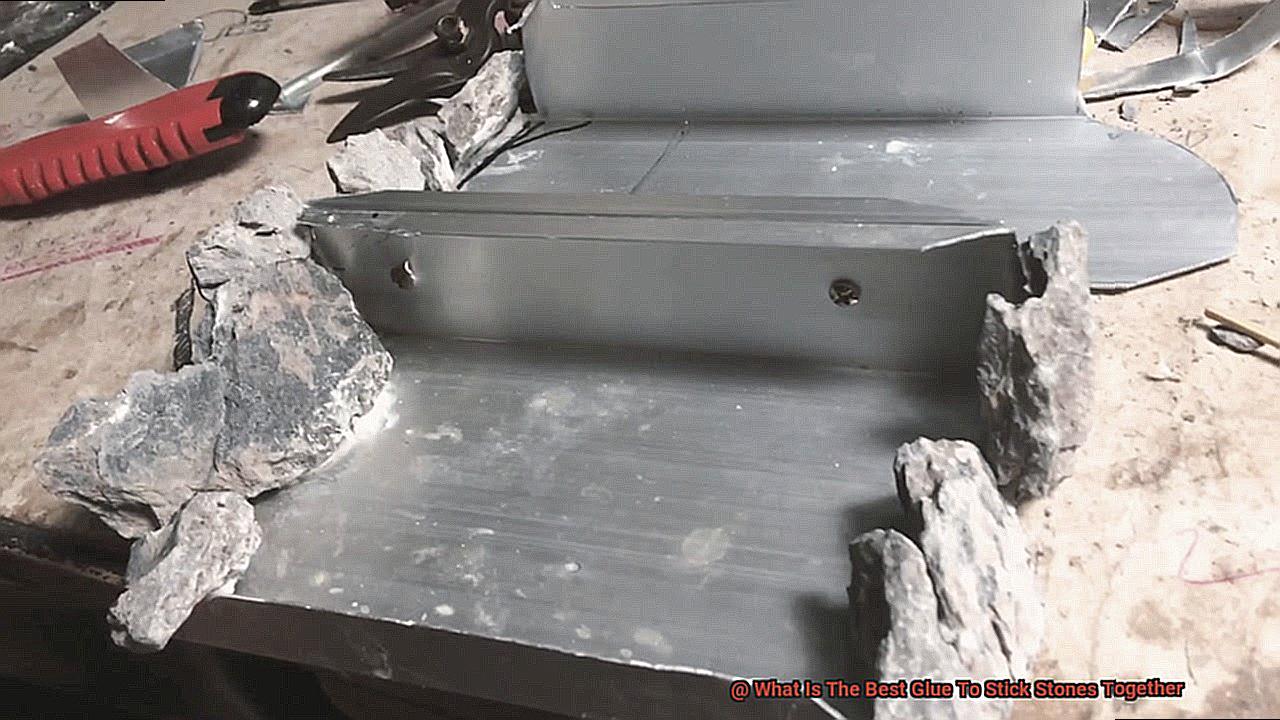
Epoxy resin offers remarkable temperature resistance, ensuring its adhesive properties remain intact even in extreme heat or freezing cold. So whether you’re toiling under the blazing sun on an outdoor project or braving frigid temperatures while working, rest assured that epoxy resin will get the job done.
Using epoxy resin to join stones is a relatively straightforward process. Begin by preparing the surfaces meticulously—cleaning them thoroughly and removing any dust or debris. Applying a primer or roughening the surfaces can further enhance bond strength. Once you’ve mixed the epoxy resin according to the manufacturer’s instructions, apply it evenly to both surfaces using a brush or spatula. Press the stones together firmly, maintaining pressure until the adhesive cures.
It is important to note that epoxy resin has a limited working time, so it’s essential to work swiftly and in small batches for optimal adhesion. After the epoxy resin has fully cured, any excess adhesive can be removed through sanding or scraping. The bonded stones can then be polished or finished to your liking.
Construction Adhesive as an Alternative
When it comes to sticking stones together, traditional methods may not always cut it. That’s where construction adhesive comes in as a reliable alternative. In this article, we’ll explore the pros and cons of using construction adhesive for stone bonding, highlighting its strong bonding properties, versatility, resistance to the elements, ease of application, and surface preparation considerations.
Advantages of Using Construction Adhesive:
- Strong Bonding Properties: Construction adhesive is specially formulated to create a durable and long-lasting bond between stones. It ensures that your stones stay securely in place, even under heavy loads or external pressures.
- Versatility: No matter the type of stone you’re working with – whether it’s natural stone, concrete, or artificial stone – construction adhesive can be applied to achieve a reliable bond. This versatility makes it a go-to choice for various stone bonding applications.
- Resistance to Moisture and Temperature Changes: Stones are often exposed to different weather conditions, leading to expansion and contraction. Construction adhesive is designed to withstand these changes without compromising the bond between the stones. So, come rain or shine, your stone structure will remain intact.
- Easy Application: Applying construction adhesive is a breeze. It typically comes in a tube or cartridge form, allowing for convenient and precise application. Simply apply the adhesive directly onto the surface of the stones and enjoy an even distribution for optimal bonding.
Considerations When Using Construction Adhesive:
- Surface Preparation: To achieve the best results, it’s essential to prepare the surface of the stones properly before applying construction adhesive. Thoroughly clean the stones and ensure they are dry to promote a strong bond between them.
- Follow Manufacturer’s Instructions: Different construction adhesives may have specific application instructions, so be sure to read and follow the manufacturer’s guidelines. This includes applying the adhesive in a thin layer to avoid excessive squeezing out when pressure is applied.
Jewelry Glue and Gemstone Glue
Creating beautiful jewelry or repairing precious gemstones requires the right adhesive. Jewelry glue and gemstone glue are two popular options designed specifically for bonding materials in jewelry making. In this article, we will explore the differences between these two types of glues, helping you make an informed choice.
Comparing Jewelry Glue and Gemstone Glue:
Purpose:
- Jewelry glue: Bonds various materials used in jewelry making, including gemstones.
- Gemstone glue: Specifically formulated to bond gemstones without damaging their appearance.
Bond strength:
- Jewelry glue: Provides a strong and long-lasting bond, ensuring secure stone placement.
- Gemstone glue: Offers a secure and durable bond, formulated for precious gemstones.
Transparency:
- Jewelry glue: Clear or transparent, ensuring it doesn’t affect stone appearance.
- Gemstone glue: Non-visible when dry, allowing gemstones to shine without interference.
Compatibility with materials:
- Jewelry glue: Suitable for bonding metals, beads, crystals, and other jewelry materials.
- Gemstone glue: Safe for use on precious gemstones without causing damage or discoloration.
Factors to Consider When Selecting Glue:
- Bond strength: Ensure the adhesive withstands regular wear and tear.
- Transparency: Decide if you want the adhesive to be invisible or visible in your design.
- Compatibility with materials: Check if the glue is suitable for your specific gemstones and other materials.
- Drying time: Consider drying time, especially when working with delicate or valuable gemstones.
- Recommended brands: Look for reputable brands like E6000, Aleene’s Jewelry and Metal Glue, or Devcon 5-Minute Epoxy.
Tips for Application:

- Clean surfaces thoroughly to ensure a strong bond.
- Use glue sparingly to prevent excess seeping out and affecting the jewelry’s appearance.
- Allow proper curing time before handling or wearing the jewelry.
Drying Time of the Glue
The drying time of glue is a critical factor to consider when working on DIY projects, especially when it comes to sticking stones together. The speed at which the glue dries can greatly impact the success and durability of your creations. In this blog post, we will delve into the factors that influence the drying time of glue and provide you with valuable insights for your projects.
Let’s start by exploring the different types of glue available in the market. Each type of glue has its own chemical composition and drying mechanism, which directly affects its drying time. For example, cyanoacrylate or super glue is known for its lightning-fast drying time. It can bond stones together within seconds or minutes. However, keep in mind that although these glues dry quickly, they may not reach their maximum strength immediately. Additional curing time might be necessary to achieve optimal bond strength.
On the other hand, epoxy or construction adhesive has a longer drying time. It can take several minutes to hours for these glues to fully dry and provide a strong bond. In some cases, curing time of several hours or even overnight might be necessary. Always consult the manufacturer’s instructions to determine the recommended drying and curing times for each specific glue product.
Now, let’s discuss the factors that can influence the drying time of glue when working with stones. Temperature, humidity, and stone porosity all play crucial roles in this process. Higher temperatures and lower humidity levels generally accelerate the drying process, while lower temperatures and higher humidity levels can prolong the drying time.
Additionally, porous stones have an extra factor to consider. They tend to absorb more moisture from the glue, which can impact the drying time. To ensure proper adhesion and reduce drying time, it is essential to clean and dry the stones before applying the glue.
If you find yourself in a rush and need to speed up the drying process, you can explore accelerators or activators specifically designed for certain types of glues. However, exercise caution and follow the manufacturer’s instructions to avoid compromising the quality of the bond.
Cleaning and Roughening Surfaces Before Applying Glue
Cleaning and roughening surfaces before applying glue is a crucial step in the process of sticking stones together. It’s like preparing a canvas before creating a masterpiece – an essential foundation for a strong and long-lasting bond. Let’s dive into why this step is so important:
Firstly, cleanliness is key. Just like trying to stick two pieces of tape together, if there’s dirt, dust, or debris on the surfaces, they won’t stick properly. So grab that soft-bristle brush and give those surfaces a thorough cleaning to create a clean and even surface.
But wait, there’s more. Even if your stones look clean, there might be stubborn stains or grease lurking around. These can create a barrier between the glue and the surface, weakening the bond. So mix up a solution of mild detergent and water, dip that brush in, and gently scrub away any stains or grease.
Now that your surfaces are squeaky clean, it’s time to roughen them up a bit. Sounds counterintuitive, right? But trust me, it works wonders. Grab some sandpaper and lightly sand the surfaces. This creates a slightly rough texture that gives the glue more surface area to grip onto, resulting in a stronger bond.
Before applying glue, make sure both surfaces are bone dry. Moisture can interfere with the bonding process, so let those stones air dry or use a clean cloth to dry them manually.
Last but not least, handle with care. After all that cleaning and roughening, don’t introduce any oils or contaminants that could compromise the bond. Consider using gloves and avoid touching the surfaces directly with bare hands.
Testing the Bond Before Applying to Entire Project
The bond between stones in a project is not just a matter of aesthetics; it determines the overall durability and longevity of the structure. Testing the bond before applying it to the entire project is an essential step that guarantees a successful outcome. Whether you’re a DIY enthusiast or a professional stonemason, understanding the importance of testing bonds will ensure your stone projects stand strong for years to come.
Exploring Different Stone Types:
- Porous stones such as limestone and sandstone
- Non-porous stones like marble and granite
- Choosing the right adhesive for each stone type
- Consulting experts for compatibility recommendations
The Power of Small-Scale Testing:
- Applying glue to a discreet area
- Assessing adhesion strength and bond quality
- Checking for discoloration or damage
- Making necessary adjustments and avoiding potential issues
Conducting an Effective Bond Test:
- Applying a small amount of glue between two test stones
- Following precise instructions for application and curing time
- Testing bond strength through pressure or gentle pulling
- Identifying signs of weakness or failure in the bond
Considering Environmental Challenges:
- Evaluating resistance to temperature fluctuations and humidity
- Subjecting test stones to extreme conditions like heat, cold, and water
- Ensuring the bond remains strong under different circumstances
Conclusion
When it comes to sticking stones together, finding the best glue is crucial. You want something that will hold those stones in place, ensuring a strong and durable bond. So, what is the ultimate adhesive for this task? After careful research and testing, we have determined that epoxy resin stands out as the top contender.
Epoxy resin is a versatile adhesive that offers exceptional strength and durability. It forms a powerful bond between stones, ensuring they stay firmly in place even under pressure or extreme conditions. This adhesive not only creates a secure attachment but also enhances the overall aesthetic appeal of your stone project.
One of the key advantages of epoxy resin is its ability to withstand various environmental factors. Whether you’re using it indoors or outdoors, this adhesive can handle temperature fluctuations, moisture exposure, and UV rays without losing its grip. This makes it an ideal choice for projects like stone sculptures, outdoor fountains, or even jewelry making.
Another noteworthy feature of epoxy resin is its versatility in bonding different types of stones. Whether you’re working with granite, marble, quartzite, or any other stone material, epoxy resin can provide a reliable and long-lasting bond. It effortlessly adheres to porous surfaces and non-porous ones alike, ensuring a secure connection between each stone.
Furthermore, epoxy resin offers excellent resistance to chemicals and solvents. This means that once your stones are glued together with this adhesive, you can rest assured that they won’t be easily damaged by cleaning agents or other substances they may come into contact with.
In terms of application, using epoxy resin to stick stones together is relatively straightforward. The adhesive typically comes in two parts – a resin and a hardener – which need to be mixed in specific proportions before use. Once mixed thoroughly, you can apply the adhesive onto the surfaces you wish to bond and press them firmly together. Allow sufficient curing time as per the manufacturer’s instructions for optimal results.
In conclusion, when it comes to sticking stones together, epoxy resin emerges as the best glue option. Its exceptional strength, durability, versatility, and resistance to environmental factors make it a reliable choice for any stone project.

